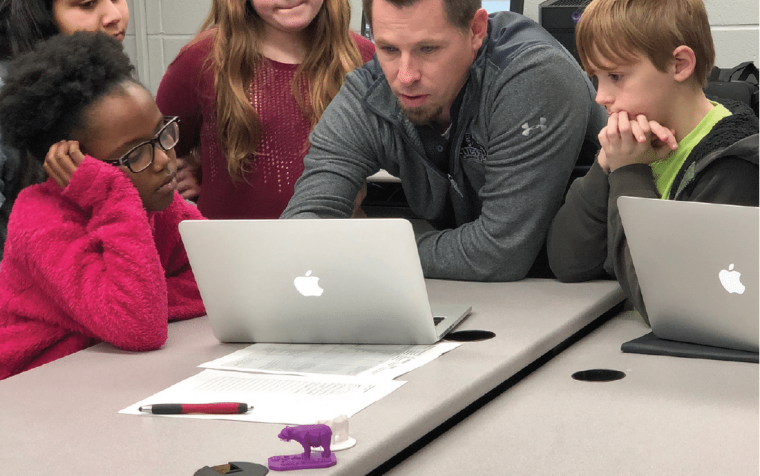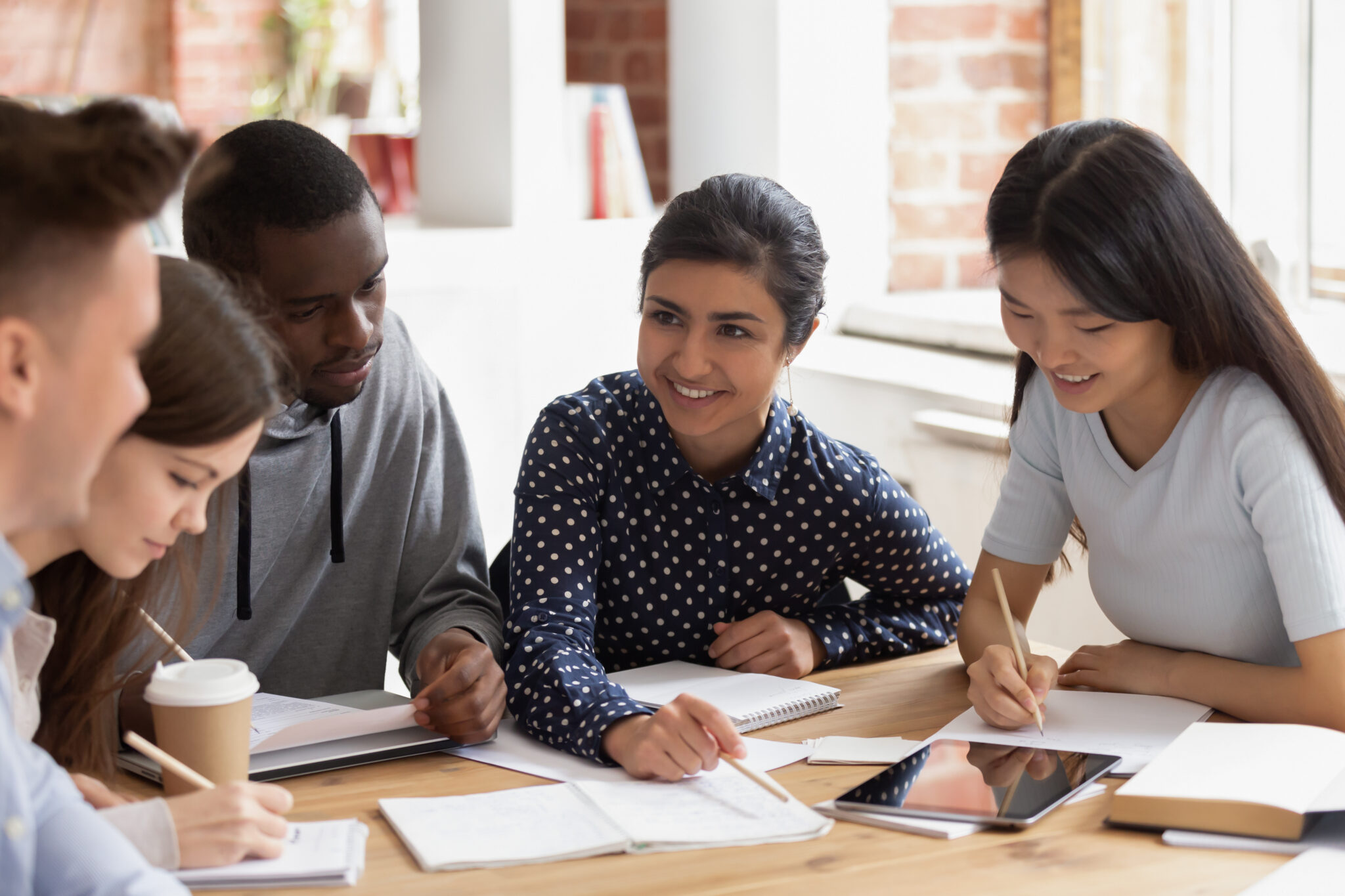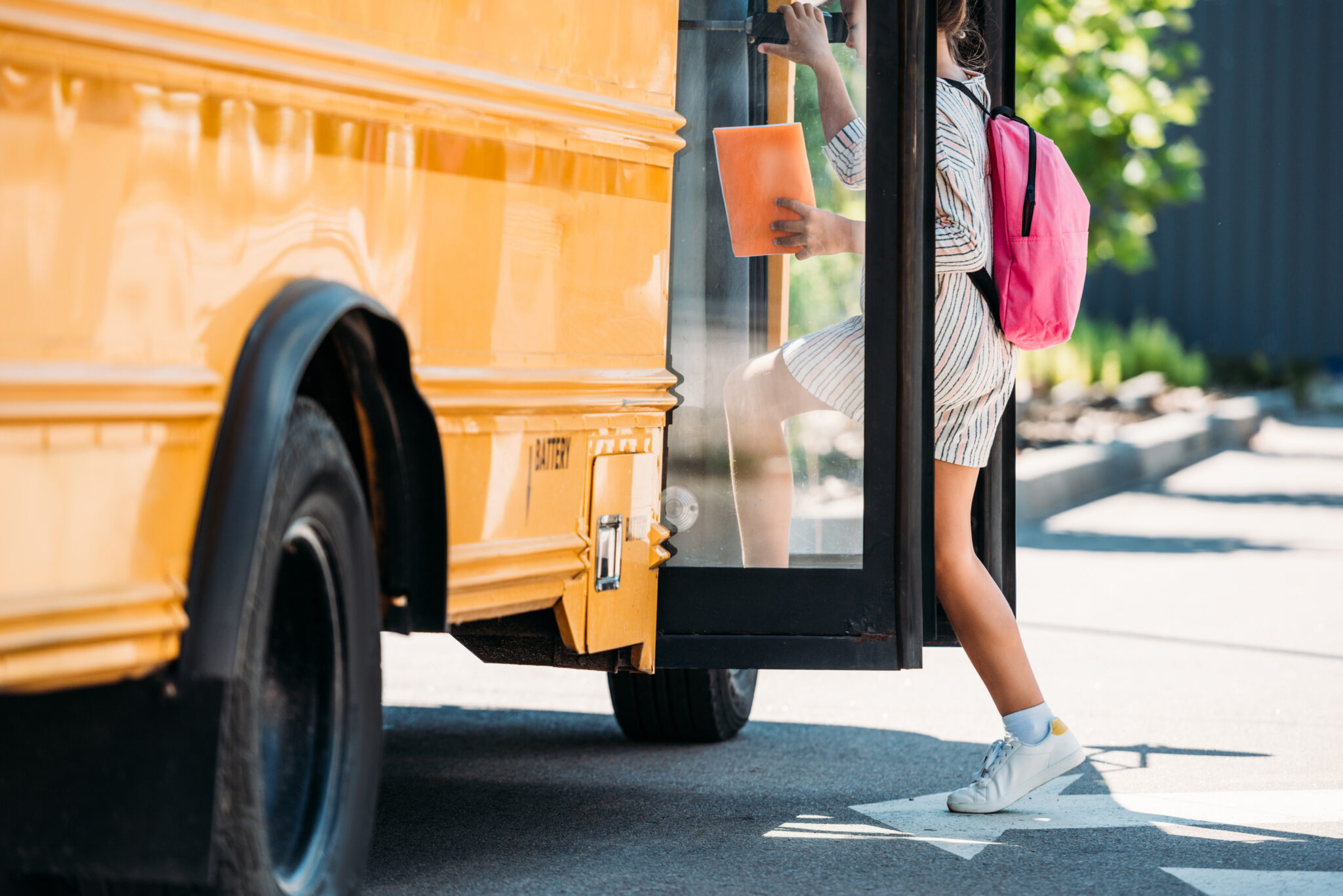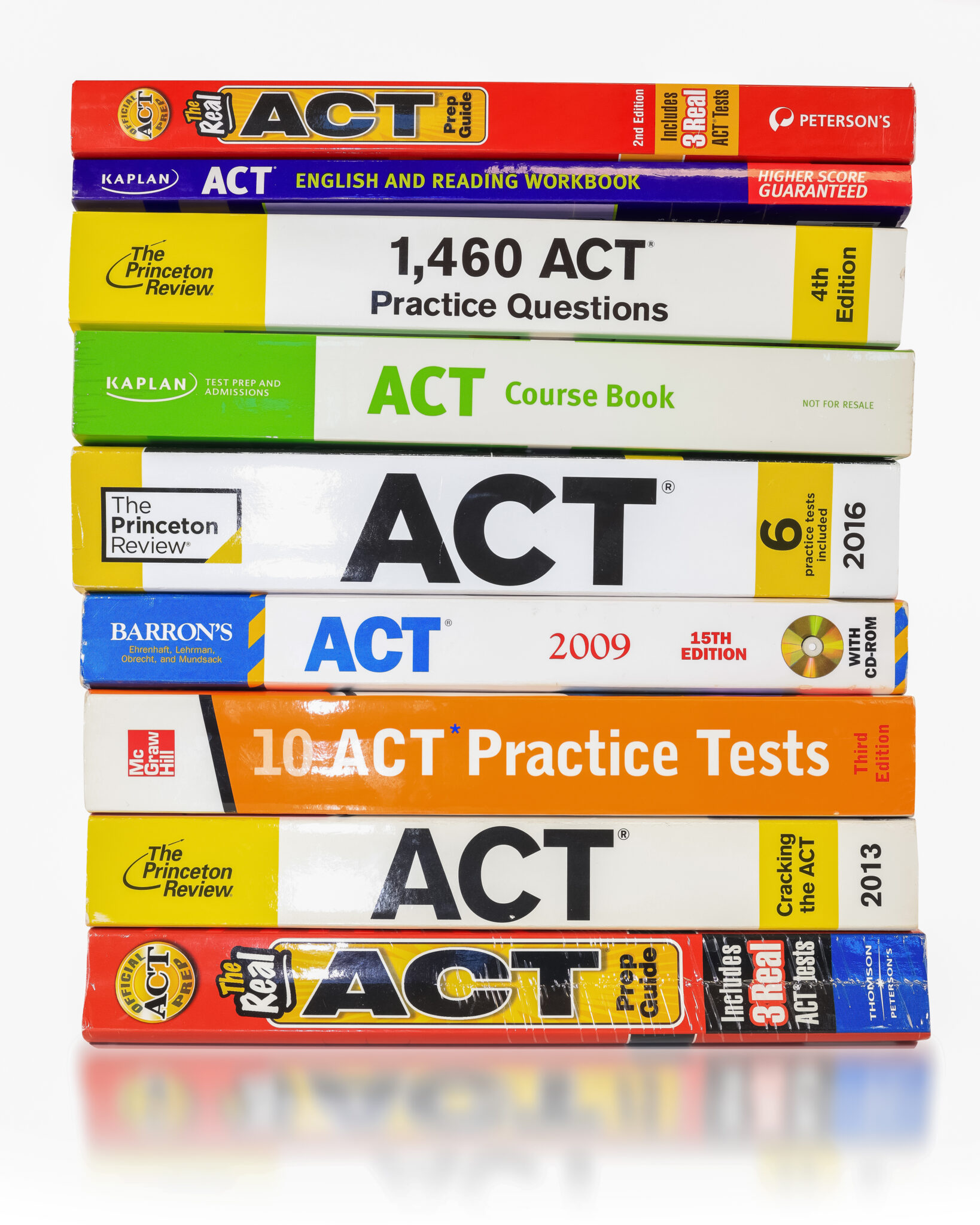She said, “My brother-in-law is missing one of his fingers. I’m sure he could use a prosthetic.” All four students looked up with those wide inquisitive eyes that are asking a million questions in a millisecond. Can we see his hand? How did it happen? How much of his fingers are gone? Can he still lift heavy things? How’s his handwriting? I wonder if we can help him?
It was a cold Saturday morning and four antsy gifted elementary students were sitting in our makerspace excited to dig into 3D printing—we were excited to test our resolve as teachers to teach the engineering design process through Project Based Learning (PBL; Buck Institute for Education, 2020). Along with the students, there were three classroom teachers who were observing and working with us for professional development credit. With four students and limited time, we wanted to focus our efforts on facilitating learning about prosthetics using the E-nable the Future (Enabling the Future, 2020) models and, as it is with all great teaching opportunities, we had to monitor and adjust. Because one of our attending teachers had a personal connection, we adjusted our curricular focus toward developing a finger prosthetic that could potentially help a real person. Our project lasted for a total of 12 hours, as we met four times for 3 hours each on Saturdays. During each meeting, we worked through our PBL model to solve this real-life problem by reverse engineering 3D models of hand prosthetics to develop a usable finger prosthetic. The amazing thing that happened in this experience was the amount of interdisciplinary learning that occurred because we chose to use a PBL model. The student-centered approach we took allowed our students to examine the anatomy of the human hand including all the bones, ligaments, and tendons, and compare their own anatomy to the structures of the prosthetics. Furthermore, the students utilized research skills in learning about the hand and how to create and print the prosthetic.
As we tell the story of what happened with these gifted students, we will share the structures that supported the gifted learning experience. Our central learning target was to increase students’ understanding and ability to engage in the engineering design process. We defined that process as follows, in alignment with current research that calls for students to engage in inquiry by critically thinking about the problem as they navigate the engineering design process and collaboratively create alternative solutions (Hill et al., 2018):
Ask: Identify a problem or ask how a system can be improved.
Imagine: Collect ideas and data about possible solutions and improvements.
Plan: Develop a set of procedures and plan for how the solutions and improvements will work.
Create: Design and manufacture solutions and test their effectiveness in solving the problem or answering the question.
Improve: Revise and recreate the solution for effectiveness and efficiency.
In teaching the engineering design process, we engaged an interdisciplinary PBL instructional design model that allowed students to drive the questioning and creation as they engaged in the engineering design process.
What Is PBL?
Approaching this challenge, we decided to utilize a PBL model for teaching. Although there are various approaches to PBL, we focused on developing the project around the Gold Standard model from PBL Works (Buck Institute for Education, 2020). This model has seven elements that surround the core learning goals. We believe that learning goals are central to the construction of any curriculum and that identifying outcomes prior to the enactment of teaching sets the teacher up for success. As we facilitated this PBL, we emphasized the central learning outcomes explicitly so both the students and teacher participants had a clear view of where the process would take us.
Challenging Problem or Question
The first design element of Gold Standard PBL (see Figure 1) is an overarching problem or question. We started with a big question that would be the driving force for our project, “How can we help our community through making?” that quickly narrowed to, “Can we use the engineering design process to create a working prosthetic?” You will notice that the question is open-ended and encourages additional student inquiry. This leads us to develop smaller inquiries that help reach the goal of answering the big question and solving the problem. We want the big question to motivate students, but be obtainable. PBL Works says that the question needs to be at the appropriate level for the students (Buck Institute for Education, 2020). To challenge gifted students, teachers should know their students’ interests, readiness, and talents and work collaboratively with them to craft the big goal-centered question (Reis & Renzulli, 2015).
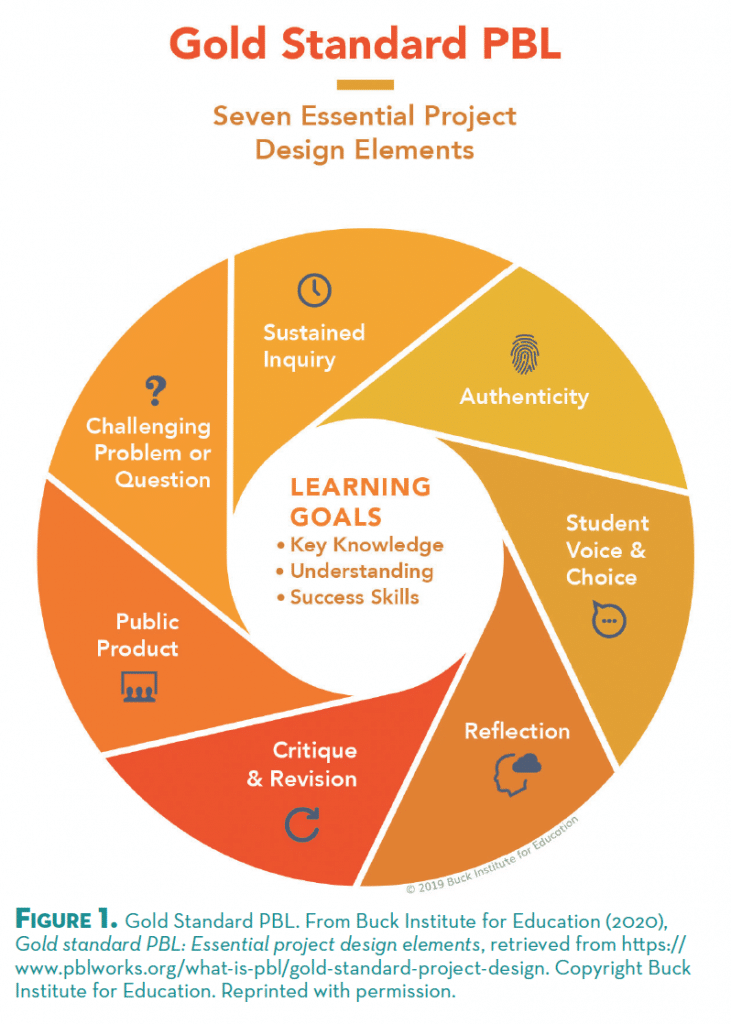
Sustained Inquiry
The next element in the PBL model is sustained inquiry. The questions students develop over the course of a PBL experience sustain the project and deepen the connections they can make with the content. In our example, the four students began asking how the previous creations worked and how they mimic the working of an actual human hand. They asked about the physics that made a prosthetic hand work, and they asked about the skills they would need to learn to redesign and adjust in Computer-Aided Design (CAD) software. As the project progressed, we kept asking questions and learning through the process—noticing that the questions stemmed from a variety of disciplines (Cotton, 2019).
The teacher’s role in our sustained inquiry was to scaffold the knowledge and skills that were essential for students’ success in the project. At the end of each session, we examined the questions and struggles the students had and planned explicit teaching for the next session that focused on developing each individual student’s knowledge and skills.
Authenticity
The element of authenticity in a PBL design is the defining factor in creating a student-centered learning experience. The challenging problem or question and learning experiences must be set in the context of the student and, in an ideal situation, the students’ prior experiences, perspectives, and passions would be central to the structure of the problem as well as the process of learning and finding solutions. Authenticity also connects the curriculum to the real world. This is what separates other projects from a PBL. The Gold Standard PBL is designed to have a real-world impact beyond the four walls of the classroom in which it occurs. As we designed our PBL around creating a finger prosthetic for a real person, our students were able to buy into the challenge. They saw a picture of a real person who they could help and they were excited to volunteer for the task.
Student Voice and Choice
If the authenticity of context defines the student-centered learning experience, student voice and choice is how the PBL maintains student buy-in and deepens learning. In PBL, students are co-learners and decision-makers with the facilitators as they navigate and work toward answering the overarching question or problem. Facilitating agency in the learning process allows students to take responsibility for their skill acquisition and increases their motivation.
Our gifted elementary students were quite inquisitive, and they were invested in the process, so allowing them to have ownership in decision making was easy. To increase voice and choice, when we encountered a problem or had an idea, we wrote it on chart paper in our maker space and, later, we discussed what new knowledge and skills we needed and how we would approach learning these things. For example, one student suggested we build a hand in virtual reality. As a group we agreed to have the student try to virtually recreate the hand with Google Blocks. The attempt was not successful, but the choice was collective, and the young learner appreciated the opportunity to try. Furthermore, he developed a greater understanding of the constraints involved with creating detailed items in virtual reality. This is one of many examples of ways the group of students worked through the PBL together as a community of learners with their eyes on the goal.
Reflection
As teachers, we understand the value of reflection. We know it increases metacognition and informs decision-making abilities. Incorporating reflection as a collective group for both students and teachers is essential to the PBL process as well. This allows for deep conversation about both process and products. As a group, we reflected on the progress we had made and identified the next steps we might take for each meeting. We considered how we contributed to the group and we asked all the co-learners to self-evaluate in relation to the learning community. Finally, we reflected on the end product and how both our process and product could be improved.
Critique and Revision
Along with reflection, ongoing learning in a PBL hinges on critique and revision. Students need the opportunity to give and receive feedback throughout the process about the quality of the products and the connections to the overall goals of the PBL. This feedback can be from peers or any of the stakeholders involved in the PBL.
We scheduled our PBL around group meetings during which we paused and provided feedback as a group to each other. Starting with our initial meeting when we all shared our wonderings about prosthetics, we stopped at the end of each hour to share what each person was working on and provide feedback to each other. Additionally, students shared informal critiques with their peers and facilitators throughout the process.
Public Product
The Gold Standard PBL Design requires that the product or solution to the big problem be shared with the public. The work and learning that happens in a PBL does not stay in the four walls of the makerspace or classroom but should be shared to the benefit of the community. This increases the stakes for the learners in a PBL because what they create in a PBL will be viewed outside the school context. For example, it was our intention to share the created finger prosthetic with the man who lost his finger. However, our time together ended before our working project was completed.
Engaging in the Engineering Design Process Through Reverse Engineering
For our PBL, we reverse-engineered the prosthetic to 3D print the finger. Reverse engineering is the process of deconstructing something that has previously been created so you can understand all about it, modify it, or rebuild it to solve a similar problem. This process is used in many disciplines, including computer science and computer applications (Martins, 2019), CAD engineering and architecture (Rueda & Escobar, 2017), and medicine and genetics (D’haeseleer et al., 2000). When we reverse engineer something, we examine all aspects of its design starting with its functional purpose and its utilization. The process we used for reverse engineering aligned with the engineering design process in the imagine and plan phases.
The Enabling the Future (2020) program provides templates of prosthetics along with instructions on how to assemble them for functionality. We started with one of these templates. Before the students arrived, we had 3D printed an entire hand and, after our first collective meeting, we analyzed the design of each part of the prosthetic and worked together to assemble a printed template. This was a challenge and took quite a bit of time. After assembling and struggling with the template, we redirected to thinking about prosthetic fingers. We found some examples of finger prosthetics and printed images. Then, using the experience of assembling the hand and the research on finger prosthetics, the students analyzed both designs and began to redesign using TinkerCAD (http://www.tinkercad.com) with the goal of creating a new prosthetic finger. As students designed the prosthetic finger in the digital space, they used the physical prosthetic as a guide, often coming back to analyze how it worked and the details of the design. They measured each part of the design and adjusted their own designs in the TinkerCAD software.
In our project, the students were able to print the pieces of the finger but the pieces they printed did not fit together correctly to work as a prosthetic. Despite the perceived failure, the students learned content, engineering, technology, and persistence, and they learned the importance of working together. If we had spent another 12 hours together, we believe (and more importantly, the students believed) we could have accomplished our goal of creating a working prosthetic finger.
Reverse-engineering is particularly suited for gifted students because it utilizes their strengths as inquisitive learners and knowledge builders (Subotnik et al., 2009). Reverse engineering can help gifted students learn better teamwork skills and teach them that learning through failure and persistence is a valuable experience. Many gifted students enjoy disassembling toys and objects to see how they work. Reverse engineering involves disassembling objects to learn about them and improve the way they function. Gifted programs can easily incorporate reverse engineering in their classrooms or makerspaces by requesting donations of old and nonworking computers, appliances, phones, and other types of technology objects. By engaging in these learning experience, students could disassemble the projects while sketching and noting how the object works. They could then use the engineering design process to describe how the object could be improved to address various problems and/or challenges, such as being more energy-efficient, producing less waste and being more environmentally friendly, and costing less money to make. An example of a lesson plan focused on reverse-engineering that is appropriate for gifted learners can be found at https://www.teachengineering.org/activities/view/csu_reverse_activity1.
What Did We Learn From Our Experience?
There were so many learning moments in our experience. From the teacher perspective, we learned about enacting both PBL and the engineering design process with gifted students. We also learned about the structures of prosthetics and the time and detail needed to successfully design and create working finger prosthetics. We learned that making is inherently experiential and that failure should be expected. We failed a lot, but we also learned from each failure.
The students who engaged with us also learned. They learned about the anatomy of the human hand. They learned about the physics, the pushes and pulls, that are needed to make a prosthetic work. They learned about measurement and scale as well as how to use additive manufacturing. They learned how to collaborate toward a common goal, and they learned how to positively communicate through failure and reflect on their learning in relation to their goals. The students communicated a strong understanding of the engineering design process.
Teaching Through PBL in Gifted Classroom Settings
We are constantly forging a pathway forward for effective and relevant teaching in all contexts. This project speaks to ways we can invigorate student inquiry and develop relevant teaching strategies for gifted students in various settings. Additionally, through experience, we recommend a few strategies for successful implementation of PBL and the engineering design process in traditional settings.
PBL and Mixed-Ability Classrooms
Teaching through PBL in the traditional, mixed-ability classroom presents unique challenges for curriculum design and classroom structures. In particular, we know that there are foundational knowledge and skills, based on standards, that must be mastered by our students. This challenge often pushes classroom teachers to design the classroom learning experiences around repetitive practice of lower level skills that will be tested. This leads the teacher to ask, “How do I structure teaching through PBL in my class and still meet the standards?” Here are a few suggestions for structuring PBL in a mixed-ability classroom.
- Develop a long-term plan: The constraints of a traditional classroom require a PBL experience to last an extended period of time. It is not uncommon for PBL to last a full semester in the traditional classroom.
- Set short-term goals with your students: As you meet regularly, set short-term, reachable goals and track them visually in the classroom. Post the goals on chart paper and celebrate each success as your students reach a goal.
- Structure each class period to include PBL time: It is easy to get bogged down in day-to-day structured learning and lose track of time. We suggest you structure the class to have, at a minimum, 10 minutes of PBL focused time. This could be a whole-group meeting, or it could be a time when students are completing an ongoing task or learning activity that contributes to short-term goals. When Dr. Trumble had his students participate in PBL, he started each class with a 5-minute warm up, and presented a mini-lesson and some practice for 20 minutes. Then, for 15 minutes, the students worked on their PBL task before coming back to a whole group meeting during which he reviewed and set goals for the next day.
The mixed-ability classroom poses particular challenges for teaching through PBL, but structuring the daily experience can lead to success and deep learning for all the students in the class.
Pull-Out and PBL
Many schools have programs in which students are pulled out of a traditional class to receive gifted services. Pull-out programs sometimes allow for more focused time on PBL, either through meeting multiple times per week or for an extended time one day a week. The difficulty in this situation is dealing with extended times between meetings. Following are some suggestions for engaging in PBL for pull-out programs.
- Allow each pull-out group to have their own PBL: Because there will be some consistency in the abilities of students that are pulled out of the classroom (versus a mixed-ability group), each group can have its own challenging problem or question. This allows for each group to collaborate on a problem that they are passionate about.
- Create a physical project home space: This is really a good idea for all PBL projects, but, because there are less frequent meetings in a pull-out program, organization of ongoing projects is essential. We suggest that as students create, modify, and iterate products, the teacher dedicates a physical space in the classroom for each group to organize and store products and project components. Creating physical space also helps the teacher in formative assessment throughout the PBL.
Homeroom and PBL
Students in middle and high school are often placed in a gifted homeroom where they meet either every day or every other day, giving teachers the opportunity to have frequent interaction and develop a whole class PBL experience. The amount of autonomy in this situation allows for incredible interdisciplinary PBL teaching opportunities. Following are a few suggestions that can contribute to the success of a PBL in a gifted homeroom situation.
- Differentiate tasks based on student interest: A PBL, in practice, is highly collaborative, but not all tasks need to be done together. In your meetings with students, it is important to evaluate student interest in various tasks. For instance, if you were to replicate our project in a homeroom situation, you may have one small group of gifted learners reverse engineering prosthetics through a CAD program while another small group maintains and operates the 3D printers. You may even have some students documenting the process and creating media that shares the project to the outside community.
- Invite outside experts: The open structure of a homeroom class and the extended time students have to learn through PBL allows for the inclusion of outside voices. This provides a great opportunity for a teacher to invite engineers to analyze project elements and contribute their knowledge as students solve unique problems. If a face-to-face meeting is not possible, students can connect to outside experts virtually. Teachers can use programs such as Skype to find experts that match student needs.
Teaching student-centered PBL in STEM classrooms can seem daunting, but the success students find in engineering solutions to authentic problems can propel them to make an impact in their community and can connect them to careers in STEM fields. We loved seeing the excitement our small group of students had as they reverse engineered a finger prosthetic and the connections they made between anatomy, mathematics, and engineering design processes. We hope you’ll try student-centered learning through PBL with your gifted learners.
References
Buck Institute for Education. (2020). Gold standard PBL: Essential project design elements. https://www.pblworks.org/what-is-pbl/gold-standard-project-design
Cotton, N. (2019). Using an interdisciplinary approach with problem-based learning for gifted learners. Learning to Teach, 8(1). https://www.utdl.edu/ojs/index.php/learningtoteach/article/view/292/176
Enabling the Future. (2020). e-Nable devices. http://enablingthefuture.org/e-nable-devices
D’haeseleer, P., Liang, S., & Somogyi, R. (2000). Genetic network inference: from co-expression clustering to reverse engineering. Bioinformatics, 16(8), 707–726.
Hill, C. P. R., Mott, M. S., & Hunt, A. (2018). Facilitating an elementary engineering design process module. School Science & Mathematics, 118(1/2), 53–60. https://doi-org.proxy.libraries.rutgers.edu/10.1111/ssm.12259
Martins, D. M. L. (2019, July). Reverse engineering database queries from examples: State-of-the-art, challenges, and research opportunities. Information Systems, 83, 89–100. https://doi.org/10.1016/j.is.2019.03.002
Reis, S. M., & Renzulli, J. S. (2015). Five dimensions of differentiation. Gifted Education Press Quarterly, 29, 2–9.
Rueda, N. A., & Escobar, J. A. (2017). Reconstruction of the lost Muisca Siecha raft pouring process by reverse engineering methodology. Materials & Manufacturing Processes, 32(7-8), 749–755. https://doi.org/10.1080/10426914.2017.1279324
Subotnik R., Orland, M., Rayhack, K., Schuck, J., Edmiston, A., Earle, J., Crowe, E., Johnson, P., Carroll, T., Berch, D., & Fuchs, B. (2009). Identifying and developing talent in science, technology, engineering, and mathematics (STEM): An agenda for research, policy, and practice. In L. V. Shavinina (Ed.), International handbook on giftedness (pp. 1313–1326). Dordrecht, The Netherlands: Springer.
Jason Trumble, Ph.D., is an assistant professor of education at the University of Central Arkansas where he teaches and researches the integration of curriculum design, pedagogy, and technology. Dr. Trumble serves as codirector of a summer camp experience for gifted and talented youth. Before teaching at UCA, Dr. Trumble taught in Belton, TX, where he designed and facilitated summer camp curriculum for gifted students. He can be found on Twitter @proftrumble.
Debbie Dailey, Ed.D., is an associate professor of education at the University of Central Arkansas where she is the coordinator for the gifted and talented program and director of a summer camp for talented youth, STEMulate Engineering Academy. Debbie currently serves as treasurer for her state gifted association (Arkansans for Gifted and Talented Education), Chair of the STEM network at NAGC, and President-Elect for CEC-TAG.
Alicia Cotabish, Ed.D., is an associate professor of teaching and learning at the University of Central Arkansas. Alicia is the former past-president of the Arkansas Association of Educational Administrators and currently serves as Co-Chair of the National Association for Gifted Children Standards Committee.


